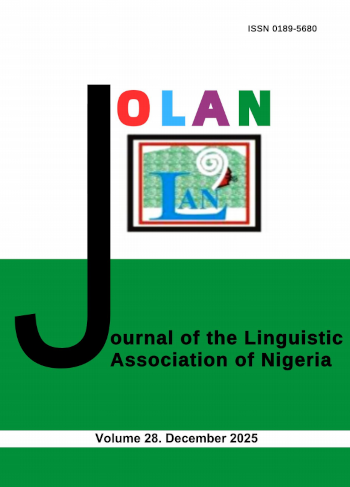The Communicative Metaphor in Idoma Idiomatic Expression and English as Panacea for Development Initiatives
Keywords:
Metaphor, Idioms, Syntax, Semantics, Sustainable Development GoalsAbstract
This study reviews the communicative metaphor and Idiomatic expression in Idoma using metaphors and idioms in the Agatu dialect. This paper is of the opinion that communication and its application has the capability that helps bridge the worlds of individuals thus aligning with scholarly submissions in some quarters that communication is indeed the process of understanding and the sharing of meaning. We maintain that, we supports scholars views that, in normal social discourse, communication takes place both in verbal and nonverbal channels and, the information being communicated is put out to the group for negotiation even though it is relatively transient. Thus the effectiveness depends of the intensity and how it is coded and this is where metaphors and idioms come in. In comparing Idiomatic expression in Idoma and the English Language, we identified best approaches embedded in both cultural and semantic ambiguity that discolour the understanding of development campaign messages aimed at engaging or mobilizing community participation. It is hoped that, an understanding of the differences in this expression will help bridge the language gap between development initiatives/workers and the community populace who to a large extent are not grounded in the different Languages, yet are the recipients of the development initiatives. This study is justifiably important because, among other things, the success of any development drive depends on how well the people participate in the initiative. To participate requires that the people fully understand the strategic requirements on their path. This study is thus directed towards identifying the metaphoric transliteration that will help foster understanding between both groups. To achieve this lofty objective, the study adopted the desk review research methodology which involves in-depth sourcing of data from secondary sources.
References
Ambrose J (2008) "Why Idioms Are Important For English Language Learners." Mikolaiv State Pedagogical University. www.lib.chdu.edu.ua/pdf/zbirnuku/7/37.pdf extracted on 2016/11/26
Baker, M. (1992) In Other Words: A Course Book on Translation. London: Routledge.
Boers F (2008). Language Awareness: Understanding Idioms at Macmillanddictionaries.Com l
DeVito, J. A. (1986). The Communication Handbook: A Dictionary. New York: Harper & Row
Goatly, Andrew. 1997. The Language of Metaphors. London: Routledge.
Goddard, C. 1998. Semantic Analysis. Oxford: Oxford University Press.
Heine, B. (1997). Cognitive Foundations of Grammar. Oxford, UK: Oxford University Press.
King, G. (2000) Good Grammar. Glasgow: Harper Collins Publishers.
Kövecses, Zoltán. (2008). “Universality And Variation In The Use Of Metaphor”, In Johannesson, Nils-Lennart & David Minugh (Eds), Selected Papers From The Metaphor Festivals, 2 Nd Ed. Stockholm: Department of English, Stockholm University.
Laflin S (1996). Something to Crow About: A Concise Collection of American English Idioms For Everyday Use. Washington D.C.: United
Lakoff, George & Johnson, Mark. (1980). Metaphors We Live By. Chicago, IL: University Of Chicago Press
Lakoff, George & Mark Johnson. (1980). Metaphors We Live By. Chicago: University Of Chicago Press.
Leah, Claudia (Nd). Idioms - Grammaticality and Figurativeness University of Oradea.
Monica Lakhwani () Spalding University, USA Robert St. Clair University Of Louisville, USA
Okpe, Agnes. 2012. A Semiotic Analysis of the Use of Metaphor in Selected Works of Wole Soyinka. PhD Thesis. Ahmadu Bello University, Zaria-Nigeria.
Pearson, J., & Nelson, P. (2000). An Introduction to Human Communication: Understanding and Sharing (P. 6). Boston, MA: McGraw-Hill.
Steven, Danver (2015). Native Peoples of the World: An Encyclopaedia of Groups, Cultures and Contemporary Issues; London and New York. Routledge (Taylor and Francis Group).
Thyab, Rana Abid (2016). The Necessity of idiomatic expressions to English Language learners, International Journal of English and Literature; Vol. 7(7) 106-111
UNESCO (2012). Language Matters For Millennium Development Goals Asia And Pacific Regional Bureau For Education Mom Luang Pin Malakul Centenary Building 920 Sukhumvit Road, Prakanong, Klongtoey Bangkok 10110, Thailand
Usman, Joshua, Mustafa, Lynda Jummai & Agu, Margaret Nonyerem (2013). International Journal of Research in Humanities, Arts and Literature ISSN (P): 2347-4564 Vol. 1, Issue 6, 47-58
Weekley, E. (1967). An Etymological Dictionary of Modern English (Vol. 1, P. 338). New York, NY: Dover Publications. Communication Is Defined As The Process Of Understanding And Sharing Meaning.














